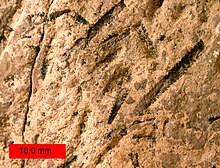Biostratigraphy
| Part of a series on |
| Paleontology |
|---|
 |
|
Paleontology Portal Category |
Biostratigraphy is the branch of
Basic concepts of biostratigraphic principles were introduced many centuries ago, going as far back as the early 1800s. A Danish scientist and bishop by the name of Nicolas Steno was one of the first geologists to recognize that rock layers correlate to the Law of Superposition. With advancements in science and technology, by the 18th century it began to be accepted that fossils were remains left by species that had become deceased and were then preserved within the rock record.[2] The method was well-established before Charles Darwin explained the mechanism behind it—evolution.[3] Scientists William Smith, George Cuvier, and Alexandre Brongniart came to the conclusion that fossils then indicated a series of chronological events, establishing layers of rock strata as some type of unit, later termed biozone.[4] From here on, scientists began relating the changes in strata and biozones to different geological eras, establishing boundaries and time periods within major faunal changes. By the late 18th century the Cambrian and Carboniferous periods were internationally recognized due to these findings. During the early 20th century, advancements in technology gave scientists the ability to study radioactive decay. Using this methodology, scientists were able to establish geological time, the boundaries of the different eras (Paleozoic, Mesozoic, Cenozoic), as well as Periods (Cambrian, Ordovician, Silurian) through the isotopes found within fossils via radioactive decay.[2] Current 21st century uses of biostratigraphy involve interpretations of age for rock layers, which are primarily used by oil and gas industries for drilling workflows and resource allocations.[5]

Fossils as a basis for stratigraphic subdivision
Fossil assemblages were traditionally used to designate the duration of periods. Since a large change in fauna was required to make early stratigraphers create a new period, most of the periods we recognize today are terminated by a major extinction event or faunal turnover.
Concept of stage
A stage is a major subdivision of strata, each systematically following the other each bearing a unique assemblage of fossils. Therefore, stages can be defined as a group of strata containing the same major fossil assemblages. French
Concept of zone
In 1856 German palaeontologist Albert Oppel introduced the concept of zone (also known as biozones or Oppel zone). A zone includes strata characterized by the overlapping range of fossils. They represent the time between the appearance of species chosen at the base of the zone and the appearance of other species chosen at the base of the next succeeding zone. Oppel's zones are named after a particular distinctive fossil species, called an index fossil. Index fossils are one of the species from the assemblage of species that characterize the zone.
Biostratigraphy uses zones for the most fundamental unit of measurement. The thickness and range of these zones can be a few meters, up to hundreds of meters. They can also range from local to worldwide, as the extent of which they can reach in the horizontal plane relies on tectonic plates and
The
Index fossils

Index fossils (also known as guide fossils, indicator fossils, or dating fossils) are the fossilized remains or traces of particular plants or animals that are characteristic of a particular span of geologic time or environment, and can be used to identify and date the containing rocks. To be practical, index fossils must have a limited vertical time range, wide geographic distribution, and rapid evolutionary trends. Rock formations separated by great distances but containing the same index fossil species are thereby known to have both formed during the limited time that the species lived.
Index fossils were originally used to define and identify geologic units, then became a basis for defining
To work well, the fossils used must be widespread geographically, so that they can be found in many different places. They must also be short-lived as a species, so that the period of time during which they could be incorporated in the sediment is relatively narrow. The longer lived the species, the poorer the stratigraphic precision, so fossils that evolve rapidly, such as ammonites, are favored over forms that evolve much more slowly, like nautiloids.
Often biostratigraphic correlations are based on a
Faunal succession

The concept of faunal succession was theorized at the beginning of the 19th century by William Smith. When William was studying rock strata he began to recognize that rock outcrops contained a unique collection of fossils.[10] The idea that these distant rock outcrops contained similar fossils allowed for Smith to order rock formations throughout England. With Smith's work on these rock outcrops and mapping around England, he began to notice some beds of rock may contain mostly similar species, however there were also subtle differences within or between these fossil groups. This difference in assemblages that appeared identical at first, lead to the principle of faunal succession, where fossil organisms succeed one another in a definite and determinable order, and therefore any time period can be categorized by its fossil extent.[11]
See also
References
- ^ Hine, Robert. "Biostratigraphy." Oxford Reference: Dictionary of Biology, 8th ed., Oxford University Press, 2019.
- ^ a b Gon, S. M. "Trilobite Biostratigraphy." Edited by Nicolas Tormo, Trilobite Biostratigraphy, 4 Sept. 2018, www.trilobites.info/biostratigraphy.htm
- ^ Gluyas, J. & Swarbrick, R. (2004) Petroleum Geoscience. Publ. Blackwell Publishing. pp. 80-82
- ^ Young, Keith (March 1960). "Biostratigraphy and the New Paleontology". Journal of Paleontology. 34: 347–348 – via JSTOR.
- ^ Simmons, Mike. (2019). ResearchGate, Biostratigraphy in Exploration. Retrieved March 5, 2020. URL: https://www.researchgate.net/publication/332188386_Biostratigraphy_in_Exploration
- ^ a b Subcommission on Quaternary Stratigraphy: Stratigraphic guide – Biostratigraphy". Quaternary Stratigraphy. International Union of Geological Sciences (IGUS); International Commission on Stratigraphy (ICS). Retrieved 2020-03-21.
- . Retrieved 2020-12-27.
- OCLC 1151203029. Retrieved 2020-12-27.
- ^ Strata Smith: The Man & The Map, 26 February 2015, retrieved 2022-09-26
- ^ Scott, Michon (May 8, 2008). "William Smith: Discovering Faunal Succession & Faunal Succession's Legacy". Earth Observatory.[page needed][ISBN missing]
